قوة دائمة للتنمية المستندامة وتغيير لافت، مترو أنفاق العاصمة سيول
ISSUES
1.1 Public transportation before the subway era
Substantial rail traffic system installed during the Japanese occupation period and its significant impact on Seoul’s urban structure
Rail Transportation is essential in the formation of city and modern civilization, because it handles larger traffic volume and its speed is faster than cars. During the colonial period, X-shaped rail traffic network was installed in Korea to mobilize Japanese capital and army and to exploit natural resources and grain. However, it served inter-regional transportation, so that its impact on traffic within cities was marginal. When Gyeongin railway became double-tracked in 1966, rail began to be used for commuting purposes, but its role for intra-city traffic was not large enough to influence Seoul’s urban structure.
Tram playing an important role in intra-city transportation from the opening port era to the 1970s
In the early 20th century, tram became important in Seoul’s transportation system, and has impacted urban growth since the opening port era until the 1970s. Unlike Japan which experienced the horse-drawn carriage era since it opened door to the Western rather early, Seoul’s transportation system changed instantly from walking to rail transport by the introduction of tram. Initiated as a part of the electricity business, tram network continued to grow as the city expanded. From the late Joseon Dynasty to the colonial period, tram was established in accordance with the urban development direction, since urban planning often included tram installment along the newly constructed roads. The tram route map in the past is similar to the current subway lines in downtown, because subway in the early days focused on supplementing the closed tram line rather than pioneering new area.
Bus becoming the only public transport in Seoul after tram stopped operation
Until the tram shut down, tram and bus dominated Seoul’s public transportation. Unlike tram that needed track construction for the extension, bus was flexible in extension, thus gradually increased its share. Establishing bus line was also an easy way to solve transportation problems in the process of urban expansion. Securing the road space based on the urban planning and issuing licenses for bus companies, the government could provide citizens with public transportation service. Although urban growth in many cities in the world was centered on the central station or railway station, Seoul grew from areas close to the downtown, depending on the bus system. As a result, congested bus lines in the downtown and the limited capacity of buses and bus stops called for new types of public transportation system.
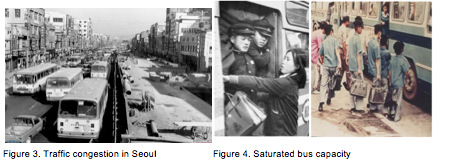
1.2 Population concentration and Traffic congestion
Population concentration in Seoul due to the central government’s economic development plan
In the 1960s, the central government pushed forward industrialization according to the economic development plan, and industrial complexes began to form around downtown Seoul and along the Gyeongin axis that connects Seoul and Incheon. While the central government was responsible for building infrastructure for industrialization, Seoul municipality took charge of creating spaces to accommodate population and economic activities concentrated in Seoul.
“Entering the 1960s, Seoul initiated a new take-off. The central government promoted industrialization, which was planned to be accommodated in Seoul and its surrounding area. Accordingly, the central government directly intervened to establish policies to support industrialization, and the local municipalities took charge of creating physical space to accommodate the increasing population and industrial activities.”
The rapid increase of the proportion of Seoul’s population from 10% of the national population in 1960 to 25% in 1990
Seoul had been the center of economy, politics, and culture since it became the capital of Joseon, the last dynasty of Korea, but its population remained only about 200,000. Since the boundary expansion in 1936, Seoul’s population reached over 700,000 and exceeded 1 million when overseas Koreans returned home after the independence. In 1960, the population in Seoul already approached 2.5 million, and the subway construction began to be considered. Since then, Seoul’s population increased by 3 million in every 10 years, eventually reaching 8.4 million in 1980. From 1960 to 1990, Seoul’s population increased by 4.3 times from 2.45 to 10.6 million, and urbanized area expanded by over 3 times, and land use density continuously increased.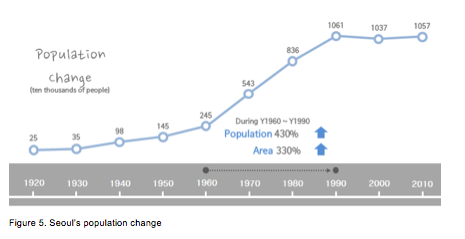
The increase of automobile traffic as Jeep, truck, and taxi used by the U.S. military began production after the Korean War
As Jeeps and trucks abandoned by U.S. military were used in the late 1950s, automobile traffic began to increase. Road conditions unsuitable for the increased traffic volume and trams operating slowly in major roads were the main obstacles to the increasing car traffic. As U.S., Europe, and Japan did when the car age had come, Seoul completely shut down tram system in 1968, and bus became the only available public transport.
Rapid growth of the motoring population due to economic development and changes in urban structure
From the 1960s through the 1970s, economic development and changes in urban structure were carried out together. In the 1960s, Gyeongin industrial district was established and the western region of the city began to be developed. Further, the formation of retail markets led to the spatial integration of urban activities near them, and most of transportation occurred within 5km radius of the city center. In the 1970s, major changes in the urban structure such as Gangnam and Yeouido development were accompanied by rapid growth of car use. However, the city center with a long history of 600 years as well as topographical characteristics of Seoul with mountains and a river obstructed the road expansion. The radial road network around the city center had limited capacity and was disproportionate to handle the east-west traffic, which was more frequent than the north-south traffic. Domestic cars were produced for the first time in 1976, and its production continued to increase more than 20% per year. Influx of cars in addition to buses and taxis that had accounted for most of the ground transportation led to severe road congestion. 
Emerging needs to introduce mass transit system
At the end of 1960s, traffic volume in Seoul already exceeded 5 million, and it continued to grow rapidly to approach 20 million in 1990 in just 20 years. The growth of traffic population in Seoul was more rapid than residential population that also grew rapidly, because each person’s trip frequency increased due to diversification of urban activities. In addition, urban expansion without dispersion of urban central function inevitably increased trip distances. As a result, excessive concentration occurred temporally during commuting time and spatially near the downtown.
| Table 1. Transportation Mode Share of Seoul in 1974 | |||
| Year | Population | Number of Passages | Registered Vehicles1) |
| 1965 | 3,543,000 | 3,145,000 | 33,223 |
| 1970 | 5,536,000 | 6,170,000 | 60,608 |
| 1975 | 6,889,000 | 8,450,000 | 160,368 |
| 1980 | 8,366,000 | 12,600,000 | 260,128 |
| 1985 | 9,645,000 | 16,723,000 | 571,772 |
| 1990 | 10,577,000 | 19,109,000 | 883,415 |
| Source : 「History of Seoul’s Transportation」, Seoul Metropolitan Government 「City Policy」, Seoul Metropolitan Government Note : 1) Estimated through interpolation |
|||
Such a rapid growth of traffic population, its concentration in the downtown, and excessive traffic congestion could not be solved by simple measures of road expansion and adding buses. Bus capacity was not large enough and road expansion for buses in the high-density urban area had limits. Faster transportation system with large capacity had to be introduced to solve this condition. For this reason, the Seoul municipality developed a plan to construct subway.
Table 2 Mode of Public Transportation and Characteristics
| Mode | Maximum Capacity per hour (persons) | Maximum persons per a carriage | Carriages per a ride | Capacity per a ride | Minimum interval (min) | Distance between stops (meter) | Cost per km |
| Bus | 1,600~2,500 | 80~125 | 1 | 80~125 | 5 | 80~250 | Low |
| BRT | 1,600~4,000 | 80~180 | 1 | 80~180 | 5 | 200~400 | High |
| Street Light Rail Transit (SLRT) |
2,000~6,000 | 100~180 | 1~3 | 100~300 | 2~3 | 400~1,000 | Medium |
| Light Rail Transit (LRT) | 5,000~20,000 | 50~120 | 2~6 | 100~720 | 1~2 | 250~600 | High |
| Heavy Rail Transit (HRT) | More than 40,000 | 90~180 | 6~10 | 540~1,800 | 2 | 1,000~3,000 | Very high |
출처: Korea Transport Institute (2004) A study on criteria to select public transportation system to fit to city size and characteristics, p.23
IMPLEMENTATION
2.1 Establishment of Subway Construction Plan
As part of three-dimensional traffic measures, The Seoul municipality planned to construct subway
During the colonial period, a Japanese private railway company promoted subway construction within the old city wall of Seoul, but the plan was suspended due to financial difficulties. Even though Tokyo was an advanced city at the time, its traffic problem was diagnosed as uncontrollable. Therefore, Japanese officials tried to address Seoul’s intensified transportation problem systematically with the government’s strong intervention and considered to introduce subway system. After independence, the National Railroad Administration examined the subway line connecting Seoul Station with Cheongnyangni Station at a minimum distance, and the plan to build it with loans was included in the first 5-year economic development plan. Afterward, subway construction was examined in various plans, exemplified by the documentation in 1964 prepared by the Seoul municipality in response to the National Assembly’s request, the Seoul municipality’s ‘10-year Plan for City Administration, and the construction plan for subway line 1 to 4 in the City Master Plan of Seoul.

Subway construction initiated as a national project
In 1970, President Chunghee Park commanded an order to “establish the construction plan for public transportation such as subway to resolve traffic congestion in Seoul” to the Seoul city government. This order served as a momentum for the subway construction which had been examined at the municipality level in the 1960s to be promoted as a national project. The central government prepared a loan and technical supports through negotiation with Japan, and the Seoul city government prepared the organization for the project implementation.
Discussion on the introduction of loan and technical support for infrastructure development in the Korea-Japan Cabinet meeting in 1970
The Korea-Japan Cabinet meeting discussed intergovernmental issues, which included loans for subway construction. Korean delegates including Minister of Transportation and Seoul Mayor discussed the validity of subway construction through inspection of Japan and working group meetings, and Japan dispatched the transport investigation group composed of railroad traffic experts to examine the feasibility of offering loan and relevant technical support. The report of the investigation group which provided fodder for subway construction in Korea suggested 5 radial lines as the optimal subway network for Seoul after 10 years. However, the report assumed the old downtown as the only CBD, showing a considerable difference from the current subway network.
2.2 First-phase Subway Construction: Transition to subway-oriented transportation system
The beginning of the first subway (line 1) construction in 1971
The plan to construct subway line 1 based on the report by the Japanese investigation group was announced. After subsequent survey and design process, the construction of the first subway line 1 started in 1971. Subway construction required technologies of various fields such as civil engineering, architecture, track, signals, electricity, communication, vehicle, and driving. Because many local engineers were trained by the economic development plan since the 1960s, Koreans did most of construction works excluding some special fields. Further, the civil engineering and construction materials excluding track, electric facility, and vehicle were procured by domestic production. The successful construction of Subway line 1 mostly done by Korean engineers contributed to the future development of the Korean civil engineering technology.
The construction plan of subway line 1 considered various aspects, which included its connections with future subway lines and introduction of the optimal system. For example, the plan included strategies to share the subway yards for line 1 with that those for line 2, unification of gauge and signal system for the through operation of the subway line 1, Gyeongin, and Gyeongwon railway, and installation of sidetrack for the operation of express subway. On the other hand, there were different opinions among departments about the introduction of the AC electric system which was already used in national railways. To minimize disturbance on communication facilities such as telephone line, subway line 1 adopted DC electric system, and both electric facilities and telephone lines were installed inside the utility tunnel.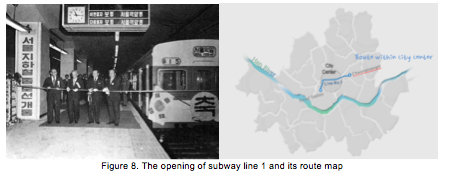
Multi-core urban structure and the construction of circulating subway line 2
Subway line 2 was originally designed in the east-west direction, connecting the Gimpo airport in the west side of Seoul and the downtown area. However, its shape changed according to the newly established urban planning. At the time, about 4.5 million people occupying 72% of Seoul’s population were living around the old downtown in the north of the river and the newly established urban planning reorganized the Seoul’s urban structure to center on three cores in order to resolve concentration of urban functions in the downtown and traffic congestion. The old downtown was to maintain its central functions, while Yeongdeungpo and Gangnam areas were expected to accommodate business and residential functions respectively. To support that, the route of line 2 was transformed to a loop line. Its section in the north of the river was designed to reflect the previously designed east-west route, while the southern section would penetrate the newly created urban cores.
When the construction of the subway line 2 was materialized, the modal share rate of subway was only 4% since its operation entirely depended on the line 1. Therefore, the Seoul city government decided to promote subway construction consistently. In particular, it planned to make a new line in the northern area where traffic demands were concentrated, as well as the subway yard. The subway line 2 extending 48.8km was planned to be developed in phases according to the demands and budgets. To reduce cost, elevated railroad was planned in sections excluding the downtown area. However, the lack of funds delayed the construction in the implementation stage until 1978 when the construction was promoted by the Seoul municipality’s own budget exclusively. As the connection between the Gangnam area being constructed and the downtown became an urgent issue, the principle of constructing sections in the northern area was abandoned and the Gangnam section was constructed preemptively, followed by phased construction of remaining sections. Considering petitions filed during the construction stage and city appearance, many sections planned to be elevated changed to the underground, which directly resulted in increased cost. 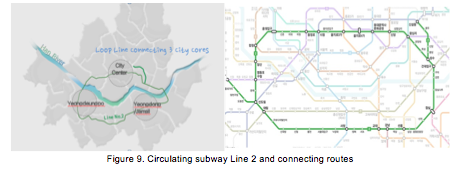
The completion of phase 1 subway network through the construction of subway line 3 and 4
Subway line 3 and 4 represented the zenith of the efforts to improve public transportation service through establishing subway network across Seoul. At the time, line 1 was in operation, penetrating the old downtown and the circulating line 2 was under construction. Subway line 3 and 4 were designed to run through major traffic axes connecting downtown to suburban areas and to enhance the ridership of line 1 and 2. In the planning process, U-shape route in which line 3 and 4 were intertwined in the downtown and ll-shape route in which new lines connect the northern and southern Seoul in parallel were considered. However, X-shape route in which they intersect in the downtown was chosen as the final route, considering the passengers’ transfer convenience.
Since enormous budget was being invested in line 2, the delay of line 3 and 4 was inevitable. Therefore, the Seoul city government considered to attract private capital for subway construction, referencing overseas private investment cases. Consequently, private investment project, in which the private sector controlled the design, construction, operation, and funding, was promoted and the central government approved the establishment of the Seoul Subway Construction Corporation. However, due to extremely poor performance behind schedule, the Seoul municipality disbanded the corporation in 1981 and the newly established Seoul Metropolitan Subway Corporation, the first public corporation wholly-owned by the Seoul municipality, took over the project.
Failure in attracting private capital for subway line 3 and 4 implies that the developing countries with inherent uncertainties such as increase of raw material price, high inflation rate and rapidly changing economic situation have limits in depending on the private sector for the promotion of mega-projects like subway construction. In particular, the government’s active support and management in securing land, fare determination, route design, supervision, and financing can ensure stable conditions for the project promotion.
The subway line 3 and 4 operating since 1985 adopted new technologies and systematic guidance system. Most of loans were utilized in introducing advanced railway technology in trend, as represented by the introduction of ATC (Automatic Train Control) with better safety and reliability than ATS (Automatic Train Stop). In addition, for efficiency and labor cost reduction, the automatic fare collection system composed of ticket vending machine, automatic ticket gate, automatic fare adjustment machine, and CCTV was established. Upon the completion of line 3 and 4, the systematic guidance system to explain subway routes extending 130km and complicated transfer system became necessary, so that simple and unified guidance design was applied to be easily appreciated by tourists as well as previous passengers. Features including subway symbol, exit design, marking of transfer stations, and representative color for each subway line were also introduced for the convenience of passengers.
2.3 Second phase subway construction: completion of trunk subway network
Request for additional subway lines and the beginning of second phase subway network
With the completion of line 3 and 4 in 1985, the first phase subway construction was finished. However, the liabilities of subway construction exceeded 2 trillion KRW and it was difficult to repay the interest, let alone the principal. Due to the continuous population growth and housing construction, the number of passengers concentrated in the commuting time began to exceed the subway capacity. As the annual increase rate of the subway ridership recorded over 10~16%, the subway capacity reached its limit in the late 1980s and the subway was called “hell train.” Everyone was aware of the necessity of additional subway construction, but specific implementation plan could not be established because of the huge deficit. In 1988, the Seoul municipality announced a plan to construct five subway routes with the assumption of the central government’s support for the construction cost, but most of planned routes were composed of extension of the previous lines and branch lines, reflecting the hopeless financial difficulties of Seoul. Afterwards the second phase subway network composed of quite a few lines was planned but could not be promoted due to lack of financial support.
Expansion of subway influential area through the construction of the arterial subway lines
In 1989, the Korea Research Institute for Human Settlements proposed the second phase subway plan, composed of arterial railways penetrating the downtown, which was different from the Seoul municipality’s previous plan extending the existing subway lines. The plan focused on rapid transit between centers and maximization of the subway service area through expanding subway influential area. The second phase subway was constructed in two steps. At the step 1, extensions of the previous line 3 and 4 were constructed, considering the service for wider area and through operation. At the step 2, four additional lines composed of line 5~8 were constructed to handle the traffic within the city. The construction of the new lines started from the outskirt rather than the downtown, with the subway yard at the ends of the lines. The tunnel methods rather than the open cut were expanded to the entire lines in order to minimize the disturbance of the road traffic.
Distinctive features of the line 5, 6, 7, and 8
Although being constructed as a part of the second phase subway, the line 5 was already considered in the plans for first phase subway network. Connecting Gimpo international airport, Yeouido business district, and the downtown, it was an important trunk route for the completion of the subway network of Seoul. To cross the Han River, the first underwater tunnel was constructed, in contrast to the bridges used in the first phase subway system.
The line 6 was planned to serve the less favored areas with poor subway accessibility in the Gangbuk area. Therefore, its ridership per distance is still lower than other lines. Its route avoided the old downtown, so that its traffic would be discharged through transfers with other lines.
The line 7 was planned to connect Gangnam and Sanggye districts developed in the 1980s. Although it was originally planned as a residential district, Ganganam area grew up as the center of business and commercial activities in Seoul, but the area was exclusively serviced by line 2. The line 7 was constructed to improve the subway network density of Gangnam and its accessibility with the highly populated northeastern area of Seoul
Line 8 connected the eastern part of Seoul with Seongnam. Originally formed as resettlement town for relocated people in the 1970s, Seongnam city had a lot of floating population. In particular, the promotion of Bundang new town in the south of Seongnam provided added impetus to the line 8 construction.
SOLUTION
3.1 Organization
The organization for the subway construction, the Subway Construction Headquarters
To promote subway construction, the Seoul municipality established the ‘Subway Construction Headquarters,’ composed of six experts in civil engineering and building sector, under the urban planning bureau in 1970. The subway construction required expertise in various fields including civil engineering, track, electricity, communication, vehicle, signal system, but recruiting professional engineers specialized in the fields was impossible in Korea at the time. To secure required knowledge in a short period of time, the headquarters interacted with domestic research institutes and universities to examine overseas engineering trends and conduct data collection and its analysis. In addition, the headquarters prepared documents to request financial and technical cooperation from Japan and took charge of educating relevant experts through overseas visits and practical training. After the start of subway line 1 construction, the scope of the headquarters’ works expanded beyond the research and design into construction and preparation for operation. In 1974, it grew up to an organization with 963 employees, composed of engineering and management parts.
Based on its construction and management experience in the line 1 construction, the Subway Construction Headquarters took charge of process planning, management planning, and management of design and construction for the line 2 construction. As the Seoul municipality decided to unify the organizations for subway construction and management which were separated into the headquarters and the Seoul Subway Construction Corporation, it disbanded the headquarters after the completion of subway line 2.
Due to rapid increase of ridership after the opening of the first phase subway network, the subway capacity soon reached its limits and the second phase subway construction was promoted since the late 1980s. At first, the Seoul Subway Corporation was considered to take the leading role in the construction of the second phase subway system, but the construction was ultimately promoted at the municipality level because it required decision-making for various issues and cooperation with the central government and related organizations. Since the previous organization for subway construction was disbanded after the completion of line 2, the Seoul municipality re-launched the Subway Construction Headquarters with 157 employees, recruiting some who had experience in the subway construction and other people dispatched from the Seoul Subway Corporation. The headquarters took control of constructing the extensions to the first phase subway lines and line 5, 6, 7, and 8. Its staff was expanded to 604 workers for the control of construction sites extending some 160km. The Seoul Subway Headquarters merged with Office of Infrastructure Management to form Seoul Metropolitan Infrastructure Headquarters, which currently handles management of infrastructure including road, bridge, and tunnel, as well as the construction of subways and light rails.
The establishment of the Seoul Metropolitan Subway Corporation for the construction of subway line 3 and 4, taking responsibility for management of the first phase subway later
The construction of subway line 3 and 4 was promoted as a private capital inducement project, but it was so delayed that the Seoul Metropolitan Subway Corporation, wholly-owned by the Seoul Metropolitan Government took over the project in 1981 and handled construction works. Its staff started with 307 employees and expanded up to 670 through reorganization and expansion during the construction period. The Seoul municipality assigned all the relevant tasks and responsibilities to the Subway Corporation to avoid problems generated by the discrepancy between constructor and operator, which included functional overlap, poor management, and lack of connectivity between projects. The corporation took full charge of operating the first phase subway networks after the completion of line 2, 3, and 4, and grew to a large-scale corporation with employees of 4,299 through reinforcement of organization. In addition, it established the ‘Subway Education Center’ to provide rapidly increasing workers with technology and job training.
Management improvement through competition, the Seoul Metropolitan Rapid Transit Corporation
As the second phase subway construction proceeded since 1990, deciding the operational body for the second phase subway became a social issue. There were opinions that a new organization should be established to improve operational efficiency through its competition with the Seoul Subway Corporation, the operator of first phase subway lines and to prepare stable operational conditions for the second phase subways by separating it from the subway corporation which had substantial debts. Based on public opinion poll, public hearing, and research outcome of professional institutions, the Seoul Metropolitan Rapid Transit Corporation was established, totally separated from the Seoul Subway Corporation, and the new corporation is still in charge of the second phase subway operation.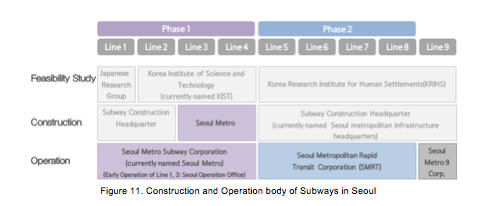
3.2 Finance
Construction of Subway Line 1, depending on the Japanese loan
The fund that could be raised by the Seoul municipality was just about 10 billion KRW, so that the deficiency had to be raised by loans or government subsidies. Most of loan was used to purchase essential vehicles and overseas equipment and to pay for technical services. The construction of 8.7km subway line 1 cost 33 billion KRW in total, and 48% of the total cost was covered by liabilities, 39.5% of which was covered by the loan from Japan. On the other hand, only 1% of the total cost was funded by the government subsidies, which was very limited considering the national concern and supporting promise in the initial stage of subway construction, and the debt burden of the Seoul municipality significantly increased.
The first phase subway network depending on the high debt funds
The construction of subway line 2 cost 877.1 billion KRW and fund raising had a lot of difficulties. The Seoul municipality’s financial status was so poor that the construction of subway line 3 and 4, which started while line 2 was under construction, was initially promoted as a private investment project. Therefore, the construction relied on the high debt funds. The debt ratio increased from 55% in the subway line 1 to 63% in line 2 and to 87% in line 3 and 4, and it was difficult to repay the principal and interest. In the long term, the debt was accumulated, burdening the Seoul municipality and related organizations.
The first phase subway construction cost 2,392.6 billion KRW in total, which was covered 23.7% by the Seoul municipality, 2.7% by the central government, and the rest by debt funds. In overseas cases, the central government often gives substantial support for the subway construction since it requires huge costs, but the governmental support in Seoul case was made only 2.7%, burdening the Seoul municipality exclusively. Accordingly, the Seoul municipality demanded more governmental support, and the central government promised to support 30% of the project budget for the second phase subway construction
The second phase subway system with lower debt ratio
Due to massive debts after the completion of the first phase subway network, the discussion on the new subway construction was suspended. In addition, the operational deficit due to lower ridership than expected brought about negative opinions on the subway expansion. However, as ridership increased by 9~16% annually, the load factor of subway reached 300% and the subway was called ‘hell train.’ As the income level increased, improvement on the subway service’s quality and quantity was requested, and the public opinion turned positive on the second phase subway construction. In response, the central government recognized the difficulties of promoting large-scale project autonomously by the local municipality and began to consider support measures through related organizations established around the prime minister. 
Compared to the first phase subway, the central government’s support for the second phase subway construction increased by 22% and the Seoul municipality’s own budget also increased by 11%, decreasing the debt funds significantly. In addition, on the contrary to the first phase subway in which multiple lines were constructed in a short period of time, the second phase subway was constructed in a longer time, which ensured funding stability.
3.3 Challenge
Oppositions from high-quality residential neighborhoods in the initial construction stage
The line 2 initially planned in the east-west direction went through frequent route modification until it was finally agreed to be the loop line. In the late 1970s when the understanding of subway was insufficient, residents in the high-quality residential neighborhoods, where the route was planned to pass through, strongly opposed the plan. In response, the Seoul municipality adopted new technologies, tunneling with minimal blasting and micro vibration to minimize disturbance in the ground level. In addition, the city explained the necessity and difficulties of subway construction and reinforced public relation activities and relevant organizations to promote anticipations that traffic congestion would be resolved by the subway system.
Disputes among residents over routes for better accessibility and development profit, resulting in the route with high bending degree and short distance between stations
The extension of the line 3 was urgent for the Gaepo district in Gangnam and for securement of the exit and entry line for the subway yard. However, the conflicts among nearby residents made the route pass through different areas. The consequential route with high bending degree and short distance between stations was the result of both poor policy making to maximize service areas with only one project and regional self-centeredness to secure the subway service at once.
The opposite cases also existed, exemplified by the Sangbong station in line 7. The Sanghong station was the transfer point between Gyeongchun railroad connecting the Gangwon province and subway line 7. In the original plan, the station was to be constructed in a location where no bending was required. However, the politicians of Gangwon province intervened to request changes in its location, deferring the construction works. The Seoul municipality conducted additional examination and confirmed the original plan on the grounds of increase in construction works, bending of routes, and allegation of improper preferential treatment.
The Project delay due to conflicting interests and demands for additional facilities
The subway yard is a necessary facility to store and maintain subway vehicles, but usually recognized as an unpleasant facility due to noise and inconvenience. Although located in the outskirt to minimize disturbance, residents nearby went on a demonstration to oppose construction and blocked the tracks, resulting in the project delay. In addition, unnecessary stations were constructed because residents pleaded. Unlike the request, such stations turned out to be less effective in the regional development and underused, thus criticized for wasting budget.
When a large-scale urban district was formed in Seoul or new town was developed in the suburb, the subway was considered as a traffic measure to provide public transportation. In many cases, light rail system was planned based on the experts’ analysis of the development scale, induced demands, and project cost, but residents often blindly requested to extend heavy railways because of lack of understanding of light rail system and residents’ desire to maximize development profit by hosting high standard facility. Such requests divided public opinions and delayed the project.
Result
4.1 Output
Establishment the first phase subway network extending 116km within short period of time
In 1985, 11 years after the opening of line 1 in 1974, the subway line 3 and 4 was completed, so that Seoul secured large-scale subway network in a short period of time. The first phase subway system with total distance of 116.5km, 113 stations and 1,944 vehicles contributed to the resolution of downtown traffic congestion and the balanced development of Seoul through multi-centralization.

Completion of the arterial subway network through the second phase subway construction
Seoul achieved remarkable growth quantitatively and qualitatively through the second phase subway system. The second phase subway expanded services to the major areas not included in the first phase subway as well as the less favored areas and created convenient environment that people could use easily. Recently, Chinese cities are expanding subways rapidly, but Seoul’s subway system still has the world’s third longest subway lines and manages the second largest traffic volume. The subway network of 327km including line 9 which opened in the 2000s, functions as the foundation for balanced urban development and sustainable growth. 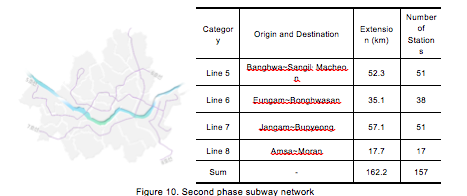
Success factors of Seoul Subway
Various factors contributed to the success of the first phase subway system, while the most essential factors are as follow. First, most of decision makers such as the President, the National Assembly, and the Seoul Mayor had a great interest in the transportation issues, which became the driving force of promoting subway construction. Second, decision makers exactly evaluated the technological level of domestic civil engineering at the time and clearly distinguished the works that could be done with domestic technology and the areas that required foreign technology. Third, the strong will overcame the national economic crisis, which included the shortage of metals and oil crisis, and completed the construction in a short period of time. In particular, it was noteworthy to overcome the high inflation and wage increase rate that can be easily found in developing countries. Fourth, unstinting administrative support for the reduction of cost and duration was effective. For example, in order to facilitate the construction work, Euljiro, a major trunk road in Seoul was closed to traffic except buses during the construction period. Lastly, plan was modified when it was required in the future prospects and aggressive investment was made in the facilities. Currently, Seoul’s subway system is in a world-class in terms of scale and transportation performance, which was possible because the facility size was modified during the construction stage to have a large-scale system with 210 meter platform and 10 cars per one ride.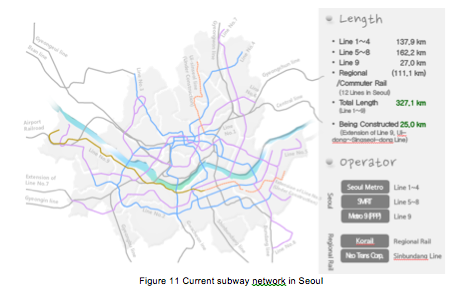
4.2 Outcome
Seoul’s subway transporting 36% of total traffic volume during its history of 40 years
The ridership of subway after the opening of line 1 in 1974 was so marginal that it could not contribute to resolving the congestion of public transport that exclusively depended on bus. However, without additional lines, its ridership rapidly increased from 270 thousands in 1976 to 540 thousands in 1980. As the operation was stabilized after the opening of line 2, 3, and 4, the first phase subway network transported 3.4 million traffics, 21% of total traffic volume. Even though the modal share rate of private cars decreased, the total traffic volume increased and the surface traffic became continuously worse. Since the mid-1990s when the second phase subway opened in phases, the modal share rate of subway exceeded 30%. On the other hand, the role of bus which was once dominant in the public transportation became weakened, as its modal share rate decreased from 80% in 1976 to 29% in 1999.
| Table 3 Change in Subway Mode Share | |||||||
| Category | 1974 | 1980 | 1985 | 1991 | 1995 | 1999 | 2010 |
| Bus | 81 | 66 | 58 | 41 | 37 | 29 | 28 |
| Subway | 1 | 7 | 14 | 21 | 30 | 34 | 36 |
| Taxi | 17 | 19 | 17 | 13 | 11 | 9 | 7 |
| Private Cars | 1 | 8 | 12 | 25 | 23 | 28 | 24 |

The subway oriented public transportation system, the basis of urban competitiveness
From the 1960s to 1980s, Seoul achieved a remarkable economic growth. As income level increased, the usage of private cars also rapidly increased, while the bus ridership continuously decreased. Subway with high punctuality, accessibility and convenient user environment became essential in citizens’ lives. In particular, the subway is assumed as the basic element in the policy promotion for the environment-friendly green transportation system to confront the recent global warming and resource depletion.
Capital, labor and market have been traditionally considered as indicators of competitiveness for cities and global corporations. However, openness, vitality and living conditions have emerged as new important factors, which are closely related with the transportation system centered on the subway. Everyone wants to live in places with convenient transportation conditions and have fast and safe transportation methods. Seoul’s subway system satisfies both and offers world-class transportation service.
Transformation from the space simply for moving to cultural and community space
Major stations with large floating population were mostly occupied by commercial facilities and people perceived the subway simply as a moving space to go to work. As time spent in stations became longer, however, some attempts have been made to utilize subway as a community space. With various facilities including meeting plaza, administration service office, meeting room, exhibition for culture and arts, festival area, and small marketplaces, subway now functions as the community space where human and material resources are gathered together, getting away from the space simply for moving. 
Lesson Learned
In a situation that the influx of population was accelerating due to economic development, bus-oriented urban transportation system could not deal with the road congestion efficiently. The plan of subway construction was materialized when the population reached 3 million, and the first subway line was completed when it exceeded 6 million. 40 years ago, Seoul had potentials but lacked capital and technology. However, with aggressive decision making and strong will, Seoul achieved an unprecedented success, constructing the subway network longer than 300 km in a short period of time and dealt with urban transportation problems with subway-oriented public transportation system. The Seoul Metropolitan Government’s investment in subway not only alleviated road congestion, but it also brought about positive effects such as decrease of accidents, reduced oil costs and optimization of user convenience, functioning as the stepping stone for realizing the potential of economic growth.
High-cost subway construction is sometimes promoted at the national level, but usually promoted at the municipality level since it handles traffic within a city. Due to lack of tax revenue compared to growing budget demands, the subway construction commonly relies on debt financing, which results in substantial financial burden even after its completion. Therefore, careful consideration has to be made on efficient financing measures such as the subsidy from the central government, overseas funds, and attraction of private capital. To avoid deficit in the operation stage, measures to increase ridership and appropriate fare system have to be provided. Recently, subway functions as a base for economic and cultural activities, getting away from a simple moving space. Three-dimensional development of stations and incidental business considering nearby land uses can provide opportunities to create new revenue. Subway project is always accompanied by risks such as over-estimation of ridership, changes in budget and duration extension in the construction process, and cumulative deficit in the operation stage. Further, priority issues may occur with large-scale investment projects in other fields that are also needed to improve the urban function. In order to overcomes such problems and distribute resources efficiently, consideration of the system to manage the establishment of plan, feasibility analysis, and design and construction process as well as the organizations and institutions in charge must take precedence.
Because of environment, energy and resource problems, the interest and status of the subway as an urban transportation method have increased more than ever. However, there is no clear-cut answer to when and in what scale subway should be constructed, due to distinctive conditions and characteristics of each city. Nonetheless, everyone agrees the positive socioeconomic effects of subway and metropolises of developing countries with accelerating population growth need to plan transportation system centered on subway with a long-term view. Seoul’s subway system that has advanced to the world-class level in the last 40 years shares its experience and technology with rapidly growing cities in developing countries through various ways such as direct project participation and consulting.
Department / Contact
- International Relations Division / 82-2-2133-5272 / international@seoul.go.kr
- Megacity Research Center / 82-2-2149-1418 / simrc@si.re.kr